Psychology 2301 Collin College Lipscomb Study Study Guide Chapter 4
Unlock all answers in this set
Unlock answersquestion
Understand the difference between the processes of sensation and perception (129 - 130).
answer
Perception is cognitive process of the brain. Sensation can be similar from one person to another. Perception can vary from person to person. Sensation is the stimulation of the sense organs. Perception is the selection, organization, and interpretation of sensory input.
question
In terms of detecting sensory stimuli, understand what is meant by threshold, absolute threshold, and JND (difference threshold) and understand signal detection theory (130 - 132).
answer
Threshold- Absolute threshold- for a specific type of sensory input is the minimum stimulus intensity that an organ can detect. JND- Just noticeable difference- is the smallest difference in stimulus intensity that a specific sense can detect. JNDs absolute threshold is simply the JND from nothing to something. Signal detection theory - purposes that the detection of stimuli involves decision processes as well as sensory processes, Better equipped to to explain some of the complexities of perceived experience in the real world.
question
Is it possible to perceive something without being aware of it? What does the evidence suggest? (132 - 133)
answer
Tied to subliminal messages, many studies mentioned in the book, advertising, the Lipton Iced Tea experiment, sexual ads, popcorn in theater and so on.
question
Understand the concept of sensory adaptation
answer
Gradual decline in sensitivity to prolonged stimulation. Ex: jumping into cold water and getting used to it, bad smells you get used to et all. Automatic built in process
question
Understand color vision and most specifically, trichromatic theory, color blindness and opponent process theory (142 - 146). Be sure to understand the main difference between the trichromatic and opponent process theories of color vision.
answer
a. Color is viewed by Wavelength (Hue) Amplitude (Brightness) and Purity (Saturation). b. Subtractive Color Mixing - Works by removing some Wavelength of light, leaving less light than originally there. c. Additive Color Mixing - Works by Superimposing Lights, putting more light in the mixture than exists in any one light by itself. d. Trichromatic Theory - Color Vision holds that the Human eye has 3 types of Receptors with differing sensitivities to different light wavelengths. e. Color Blindness - Inability to distinguish variety among colors. f. Complementary Colors - Pairs of Colors that produce gray tones when mixed together. g. Afterimage - A visual image that persists after a stimulus is removed. h. Opponent Process Theory - Ewald Hering - Color Vision holds that color perception depends on receptors that make antagonistic responses to three pairs of colors. i. Recent Studies show both Theories are somewhat Right. i. There are 3 Different Types of Cones
question
Subliminal Perception
answer
The registration of Sensory Input without conscious awareness. Such as Subliminal Messages in movies, advertisements, etc. John Krosnick - Experimented and found that "Subliminal stimulation generally produces weak effects.
question
Sensory Adaptation
answer
The Gradual Decline in Sensitivity to prolonged Stimulation. i. Ex. You jump in Cold Water; it is very cold at first, But You Get Used to It. ii. Process that keeps people tuned into the changes rather than constants in Sensory Input.
question
The Stimulus: Light
answer
i. People need Light to See ii. Light - Form of Electromagnetic Radiation that travels as a wave at the Speed of Light. iii. Amplitude - Affects perception of brightness (Height). iv. Wavelength - Affects perception of Color (Distance between Peaks).
question
The Eye
answer
i. Two Purposes: Channel light to the Neural Tissue that receives it (Retina). And they House the Retina. ii. Lens - Transparent eye Structure that focuses the light rays falling on the Retina. iii. Nearsightedness - Caused by Retina, Close objects are seen clearly, but distant objects appear blurry. iv. Farsightedness - Distant objects are seen clearly, but close objects appear blurry. v. Pupil - The opening into the center of the Iris that permits light to pass into the rear chamber of the eye. vi. Iris - Regulates the amount of Light entering the Pupil by controlling the size of the Pupil.
question
The Retina
answer
i. Retina - Neural Tissue lining the inside back surface of the eye; it absorbs light, processes images, and sends visual information to the brain. 1. The Retina is a part of the Central Nervous System. ii. Optic Disk - A hole in the Retina where the Optic Nerve Fibers exit the eye.
question
Visual Receptors: Rods & Cones
answer
i. Rods Outnumber Cones. ii. Located in the Retina. iii. Cones - Play a key role in Daylight Vision and Color Vision. iv. Fovea - Tiny spot in the center of the Retina that contains only Cones; visual clarity is best here. v. Rods - Play a key role in Night Vision and Peripheral Vision. 1. When you want to see an object in the dark, look slightly above or below where it should be to find it easier.
question
Dark and Light Adaptation
answer
i. Dark Adaptation - The process in which the eye becomes more sensitive to light in low illumination. ii. Light Adaptation - Process in which the eye becomes less sensitive to light in High Illumination.
question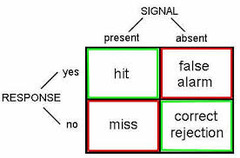
Signal detection theory

answer
the sensation of sensory inputs is influenced by the "noise" in the system and by decision making strategies. Replaces Fechner's sharp threshold with the concept of detectability and emphasizes factors besides stimulus intensity influence detectability.
question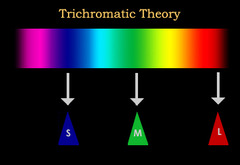
Trichromatic Theory

answer
Color Vision holds that the Human eye has 3 types of Receptors with differing sensitivities to different light wavelengths.
question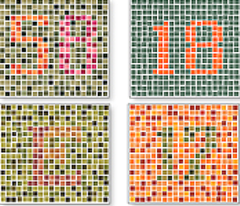
Color Blindness

answer
Inability to distinguish variety among colors
question
Opponent Process Theory
answer
Ewald Hering - Color Vision holds that color perception depends on receptors that make antagonistic responses to three pairs of colors. i. Recent Studies show both Theories are somewhat Right. i. There are 3 Different Types of Cones which The opponent-process theory of color vision was developed by Ewald Hering who noted that there are some color combinations that we never see, such as reddish-green or yellowish-blue. Opponent-process theory suggests that color perception is controlled by the activity of two opponent systems; a blue-yellow mechanism and a red-green mechanism.
question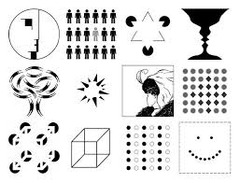
Gestalt Psychology

answer
Gestalt psychology or gestaltism (German: Gestalt "shape, form") is a theory of mind of the Berlin School. Gestalt psychology tries to understand the laws of our ability to acquire and maintain meaningful perceptions in an apparently chaotic world. k. The Whole is greater than the Parts. l. Top-Down Processing Principle
question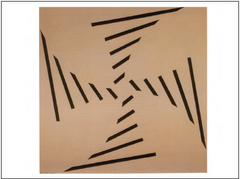
Gestalt Psychology II

answer
Illusion of movement phi phenomenon
question
Gestalt Principles
answer
How the Visual System Organizes a Scene into discreet forms
question
Gestalt Principles Proximity and Closure
answer
ii. Proximity - Elements that are close to one another are grouped together. iii. Closure - Viewers Supply Missing Elements to close or complete a Familiar figure. iv. Similarity - Elements that are similar are grouped together. v. Simplicity - Viewers Organize elements in the simplest way Possible. vi. Continuity - Viewers see elements in ways that produce smooth Continuation
question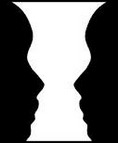
Gestalt Principles Figure and ground

answer
i. Figure and Ground - 1. Figure = Object being Looked at. a. Has More Substance, appear Closer, and Stand Out. 2. Ground = Background.
question
Discuss the subjectivity of form perception and the phenomenon of inattentional blindness.
answer
Reversible figures and perceptual sets demonstrate that the same visual input can result in very different perceptions. Form perception depends on both the selection and interpretation of sensory inputs. Inattentional blindness involves the failure to see readily visible objects.
question
Explain feature analysis, and distinguish between bottom-up and top-down processing.
answer
According to feature analysis theories, people detect specific features in stimuli and build them into recognizable forms through bottom-up processing, which involves a progression from elements to the whole. However, form perception also involves top-down processing, which involves a progression from the whole to the elements.
question
Describe Gestalt principles of visual perception, and clarify the nature of perceptual hypotheses.
answer
Gestalt psychology emphasized that the whole may be greater than the sum of its parts (features). Objects are more likely to be viewed as figure rather than ground when they are smaller, higher in contrast or symmetry, and lower in one's frame of view. Gestalt principles of form perception include proximity, similarity, continuity, closure, and simplicity. Other approaches to form perception emphasize that people develop perceptual hypotheses about the external stimuli that could be responsible for various patterns of sensory stimulation.
question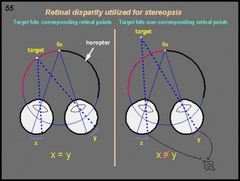
Describe the monocular and binocular cues used in depth perception, and discuss cultural variations in depth perception.

answer
Binocular cues such as retinal disparity and convergence can contribute to depth perception. Depth perception depends primarily on monocular cues, including pictorial cues such as texture gradient, linear perspective, light and shadow, interposition, relative size, and height in plane. People from pictureless societies have some difficulty in applying pictorial depth cues to two-dimensional pictures.
question
Describe perceptual constancies and illusions in vision, and discuss cultural variations in susceptibility to certain illusions.
answer
Perceptual constancies in vision help viewers deal with the ever-shifting nature of sensory input. Visual illusions demonstrate that perceptual hypotheses can be inaccurate and that perceptions are not simple reflections of objective reality. Researchers have found some interesting cultural differences in susceptibility to the Müller-Lyer and Ponzo illusions.
question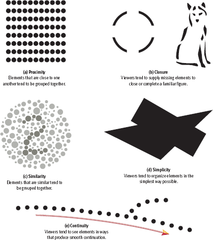
Gestalt Principles of Perceptual Organization

answer
Gestalt principles help explain some of the factors that influence form perception. (a) Proximity: These dots might well be organized in vertical columns rather than horizontal rows, but because of proximity (the dots are closer together horizontally), they tend to be perceived in rows. (b) Closure: Even though the figures are incomplete, you fill in the blanks and see a circle and a dog. (c) Similarity: Because of similarity of color, you see dots organized into the number 2 instead of a random array. If you did not group similar elements, you wouldn't see the number 2 here. (d) Simplicity: You could view this as a complicated 11-sided figure, but given the preference for simplicity, you are more likely to see it as an overlapping rectangle and triangle. (e) Continuity: You tend to group these dots in a way that produces a smooth path rather than an abrupt shift in direction.
question
Depth perception
answer
Depth perception involves interpretation of visual cues that indicate how near or far away objects are. To make judgments of distance, people rely on a variety of cues, which can be classified into two types: binocular and monocular ( Hochberg, 1988; Proffitt ; Caudek, 2003).
question
Binocular Cues
answer
Because they are set apart, the eyes each have a slightly different view of the world. Binocular depth cues are clues about distance based on the differing views of the two eyes. Today's 3D movies take advantage of this fact. Two cameras are used to record slightly different images of the same scene. The special polarized glasses that viewers wear separate the images for each eye. The brain then supplies the "depth," and you perceive a three-dimensional scene. Binocular Cues
question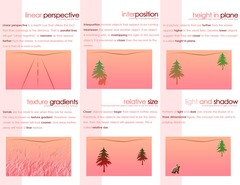
Monocular depth cues

answer
Monocular depth cues are clues about distance based on the image in either eye alone. There are two kinds of monocular cues to depth. One kind is the result of active use of the eye in viewing the world. For example, if you cover one eye and move your head from side to side, closer objects appear to move more than distant objects.
question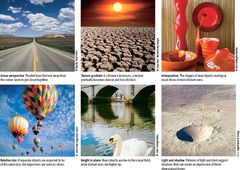
Figure 4.32

answer
Six pictorial depth cues are explained and illustrated here. Although one cue stands out in each photo, in most visual scenes several pictorial cues are present. Try looking at the light-and-shadow picture upside down. The change in shadowing reverses what you see.
question
Convergence
answer
Involves sensing the eyes converging toward each other as they focus on Closer Objects.
question
Motion Parallax
answer
Images at different distances move across the Retina at different Rates
question
Perceiving Geographical Slant
answer
Hills Look even steeper when people are tired.
question
Perceptual Consistency
answer
A tendency to experience a stable perception in the face of Continually Changing Sensory Input.
question
Perceptual Constancies in Vision
answer
When a person approaches you from a distance, his or her image on your retinas gradually changes in size. Do you perceive that the person is growing right before your eyes? Of course not. Your perceptual system constantly makes allowances for this variation in sensory input. In doing so, it relies in part on perceptual constancies. A perceptual constancy is a tendency to experience a stable perception in the face of continually changing sensory input. Among other things, people tend to view objects as having a stable size, shape, brightness, hue, and texture ( Goldstein, 2010).
question
Power of Misleading Cues: Visual Illusions
answer
In general, perceptual constancies, depth cues, and principles of visual organization (such as the Gestalt laws) help people perceive the world accurately. Sometimes, however, perceptions are based on inappropriate assumptions, and visual illusions can result. A visual illusion involves an apparently inexplicable discrepancy between the appearance of a visual stimulus and its physical reality.
question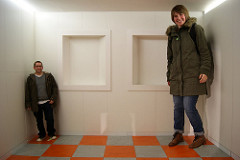
The Ames Room

answer
The diagram on the right shows the room as it is actually constructed. However, the viewer assumes that the room is rectangular, and the image cast on the retina is consistent with this hypothesis. Because of this reasonable perceptual hypothesis, the normal perceptual adjustments made to preserve size constancy lead to the illusions described in the text. For example, naive viewers "conclude" that the boy on the right is much larger than the other, when in fact he is merely closer.
question
More on Perception

answer
Unlike people in Western nations, the Zulus live in a culture where straight lines and right angles are scarce. Thus, they are not affected by such phenomena as the Müller-Lyer illusion nearly as much as people raised in environments that abound with rectangular structures. What do illusions reveal about visual perception? They drive home the point that people go through life formulating perceptual hypotheses about what lies out there in the real world. The fact that these are only hypotheses becomes especially striking when the hypotheses are wrong, as they are with illusions. Finally, like ambiguous figures, illusions clearly demonstrate that human perceptions are not simple reflections of objective reality. Once again, we see that perception of the world is subjective. These insights do not apply to visual perception only. We'll encounter these lessons again as we examine other sensory systems, such as hearing, which we turn to next.
question
Describe how sensory processing occurs in the ear.
answer
Sound is transmitted through the external ear via air conduction to the middle ear. In the middle ear, sound waves are translated into the vibration of tiny bones called ossicles. In the inner ear, fluid conduction vibrates hair cells along the basilar membrane in the cochlea. These hair cells are the receptors for hearing.
question
The Stimulus: Sound
answer
Sound waves are vibrations of molecules, which means that they must travel through some physical medium, such as air. They move at a fraction of the speed of light. Sound waves are usually generated by vibrating objects, such as a guitar string, a loudspeaker cone, or your vocal cords. However, sound waves can also be generated by forcing air past a chamber (as in a pipe organ), or by suddenly releasing a burst of air (as when you clap).
question
Sound, the Physical Stimulus for Hearing

answer
(a) Like light, sound travels in waves—in this case, waves of air pressure. A smooth curve would represent a pure tone, such as that produced by a tuning fork. Most sounds, however, are complex. For example, the wave shown here is for middle C played on a piano. The sound wave for the same note played on a violin would have the same wavelength (or frequency) as this one, but the "wrinkles" in the wave would be different, corresponding to the differences in timbre between the two sounds. (b) The table shows the main relations between objective aspects of sound and subjective perceptions.
question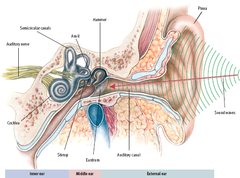
Sensory Processing in the Ear

answer
Converting sound pressure to information processed by the nervous system involves a complex relay of stimuli. Waves of air pressure create vibrations in the eardrum, which in turn cause oscillations in the tiny bones in the inner ear (the hammer, anvil, and stirrup). As they are relayed from one bone to the next, the oscillations are magnified and then transformed into pressure waves moving through a liquid medium in the cochlea. These waves cause the basilar membrane to oscillate, stimulating the hair cells that are the actual auditory receptors (see Figure 4.44).
question
The Chemical Senses: Taste and Smell
answer
Psychologists have devoted most of their attention to the visual and auditory systems. Although less is known about the chemical senses of taste and smell, both play a critical role in people's experience of the world. Let's take a brief look at what psychologists have learned about the gustatory system—the sensory system for taste—and its close cousin, the olfactory system—the sensory system for smell.
question
Describe the stimulus and receptors for taste, and discuss some determinants of taste preferences.
answer
he taste buds are sensitive to four basic tastes: sweet, sour, bitter, and salty. Umami (savory) may represent a fifth basic taste. Sensitivity to these tastes is distributed unevenly across the tongue, but the variations are small. Some basic taste preferences appear to be innate, but taste preferences are largely learned as a function of what one is exposed to. Taste preferences are also heavily influenced by cultural background.
question
Review research on individual differences in taste sensitivity, and explain what is meant by the perception of flavor.
answer
Supertasters are much more sensitive to some tastes than nontasters, with medium tasters falling in between these extremes. Nontasters tend to be more susceptible to the lure of sweets, high-fat foods, alcohol, and smoking, which means their consumption habits tend to be less healthy than those of supertasters. The perception of flavor involves a mixture of taste, smell, and the tactile sensation of food in one's mouth.
question
Describe the stimulus and receptors for smell and discuss humans' olfactory abilities. Answer
answer
Like taste, smell is a chemical sense. Chemical stimuli activate receptors, called olfactory cilia, that line the nasal passages and are constantly replaced. Smell is the only sense that's not routed through the thalamus. Humans can distinguish a huge number of odors, but their performance on odor identification tasks tends to be mediocre. Nonetheless, humans have greater olfactory capacities than widely believed.
question
The Gustatory System: Taste
answer
The physical stimuli for the sense of taste are chemical substances that are soluble (dissolvable in water). The gustatory receptors are clusters of taste cells found in the taste buds that line the trenches around tiny bumps on the tongue (see Figure 4.45). When these cells absorb chemicals dissolved in saliva, they trigger neural impulses that are routed through the thalamus to the cortex. Interestingly, taste cells have a short life. They last only about ten days and are constantly being replaced ( Cowart, 2005).
question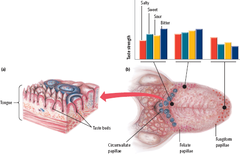
The Tongue and Taste

answer
Taste buds are clustered around tiny bumps on the tongue called papillae. The three types of papillae are distributed on the tongue as shown here. The taste buds found in each type of papillae show slightly different sensitivities to the four basic tastes, as mapped out in the graph at the top. Thus, sensitivity to the primary tastes varies across the tongue, but these variations are small, and all four primary tastes can be detected wherever there are taste receptors.
question
Culture and Taste Preferences
answer
Taste preferences are heavily influenced by learning and vary dramatically from one society to the next, as these examples demonstrate. Research by Linda Bartoshuk and others reveals that people vary considerably in their sensitivity to certain tastes. These individual differences depend in part on the density of taste buds on the tongue, which appears to be a matter of genetic inheritance ( Bartoshuk, 1993a). People characterized as non-tasters, as determined by their insensitivity to PTC (phenythiocarbamide), or its close relative, PROP (propylthiouracil), tend to have about one-fourth as many taste buds per square centimeter as people at the other end of the spectrum, who are called super-tasters ( Miller & Reedy, 1990). Supertasters also have specialized taste receptors that are not found in nontasters ( Bufe et al., 2005). In the United States, roughly 25% of people are nontasters, another 25% are supertasters, and the remaining 50% fall between these extremes and are characterized as medium tasters ( Di Lorenzo & Youngentob, 2003). Supertasters and nontasters respond similarly to many foods, but supertasters are much more sensitive to certain sweet and bitter substances ( Prescott, 2010). These variations in sensitivity mean that when two people taste the same food they will not necessarily have the same sensory experience. Thus, in regard to taste, different people live in somewhat different sensory worlds ( Breslin, 2010).
question
Hermann von Helmholtz
answer
This nineteenth-century theorist developed both the trichromatic theory of color vision and the place theory of pitch perception.
question
Linda Bartoshuk
answer
This person has conducted a great deal of influential research on the gustatory system, including pioneering work comparing supertasters and nontasters.
question
David Hubel and Torsten Wiesel
answer
This research team won a Nobel prize for discovering three types of specialized visual cells in the occipital lobe, which have been characterized as feature detectors.
question
Ronald Melzack and Patrick Wall
answer
In the 1960s, these theorists developed the gate-control theory of pain, which holds that incoming pain signals can be blocked by neural mechanisms.
question
Max Wertheimer
answer
This advocate of Gestalt psychology, who was the first person to describe the phi phenomenon, asserted that in perception, the whole is often greater than the sum of its parts.
question
What is the kinesthetic system and vestibular system?
answer
The Kinesthetic Sense is the sense that informs you about the position and motion of parts of the body. It allows you to bring your finger to your nose even if your eyes are closed. The Vestibular Sense provides your brain with information as to whether or not you are upright. It tells you, for instance, that you are lying down the second that you wake up. (That's why we usually do not fall out of bed)
question
In psychophysical research, the absolute threshold has been arbitrarily defined as:
answer
the stimulus intensity that can be detected 50% of the time.
question
A tone-deaf person would probably not be able to tell two musical notes apart unless they were very different. We could say that this person has a relatively large:
answer
just noticeable difference.
question
In their study of the influence of subliminal perception, Karremans and his colleagues (2006) found:
answer
evidence that subliminal stimuli influenced subjects' drink preferences.
question
n farsightedness:
answer
the focus of light from close objects falls behind the retina.
question
The collection of rod and cone receptors that funnel signals to a particular visual cell in the retina make up that cell's:
answer
Receptive field
question
The visual pathway that has been characterized as _______________ travels through the dorsal stream to the parietal lobes, whereas the pathway that has been labeled the ________________ travels through the ventral stream to the temporal lobes.
answer
the where pathway; the what pathway
question
Which theory would predict that the American flag would have a green, black, and yellow afterimage?
answer
Opponent process theory
question
The illusion of movement created by presenting visual stimuli in rapid succession is called:
answer
the phi phenomenon.
question
In a painting, train tracks may look as if they go off into the distance because the artist draws the tracks as converging lines, a pictorial cue to depth known as:
answer
linear perspective
question
The fact that cultural groups with less exposure to carpentered buildings are less susceptible to the Müller-Lyer illusion suggests that:
answer
perceptual inferences can be shaped by experience.
question
The hair cells that serve as auditory receptors are found:
answer
on the basilar membrane in the cochlea.
question
Perception of pitch can best be explained by:
answer
both place theory and frequency theory.
question
In what way(s) is the sense of taste like the sense of smell?
answer
The physical stimuli for both senses are chemical substances dissolved in fluid.
question
Which school of painting applied the theory of feature analysis to canvas by building figures out of simple features?
answer
Cubism
question
In the study by Kenrick and Gutierres (1980), exposing male subjects to a TV show dominated by extremely beautiful women:
answer
decreased their ratings of the attractiveness of a prospective date.



